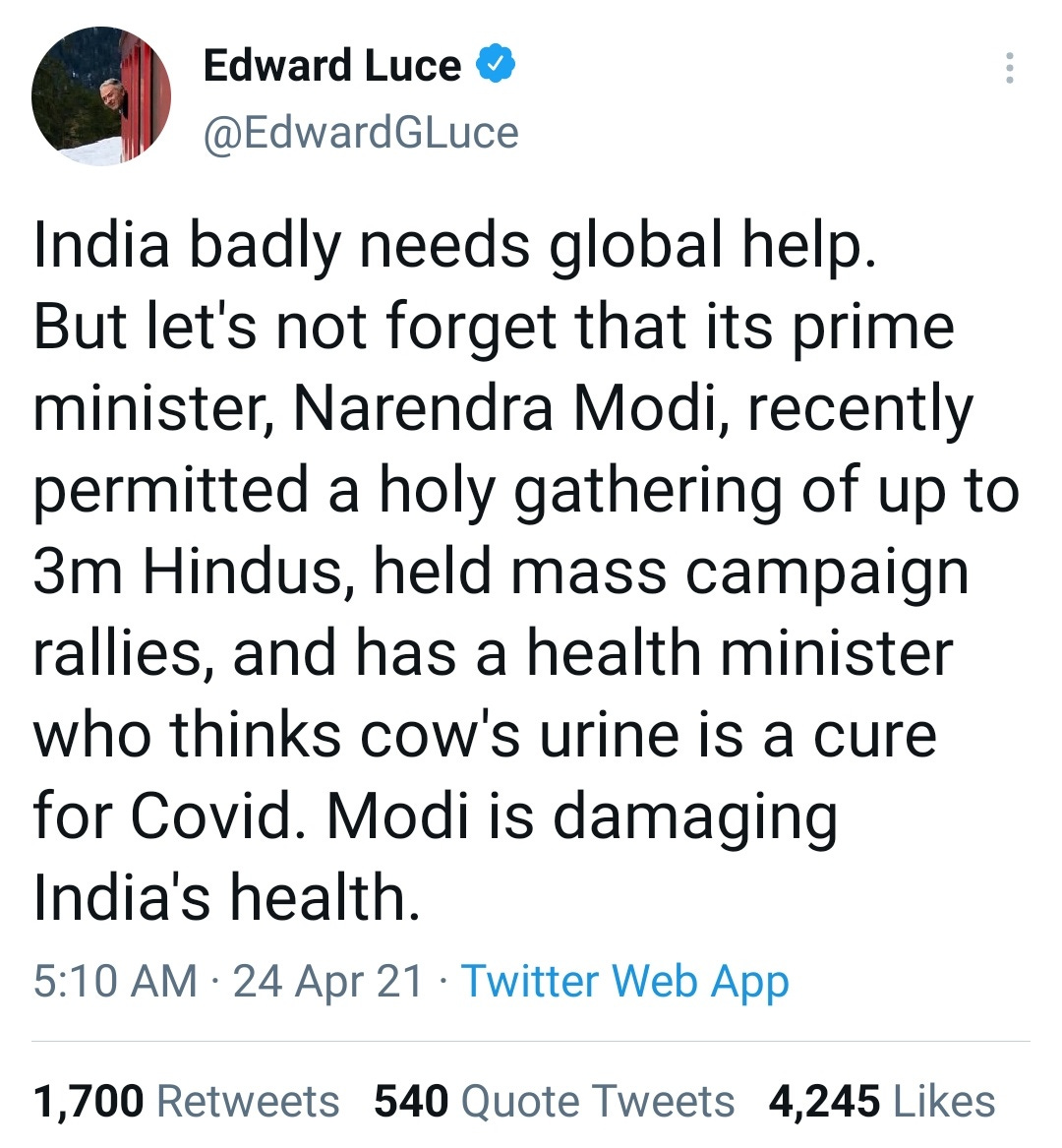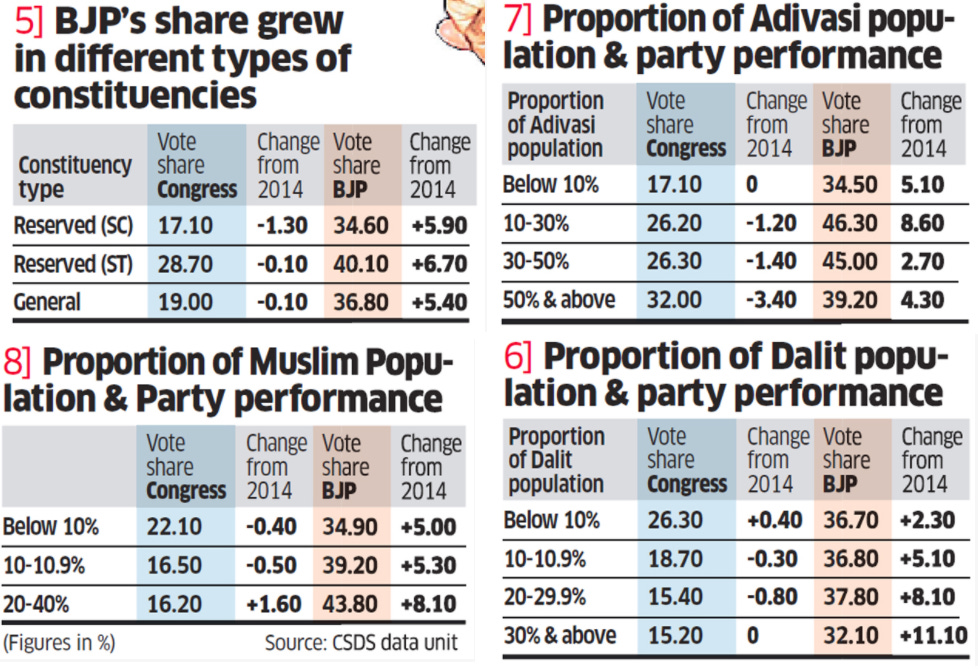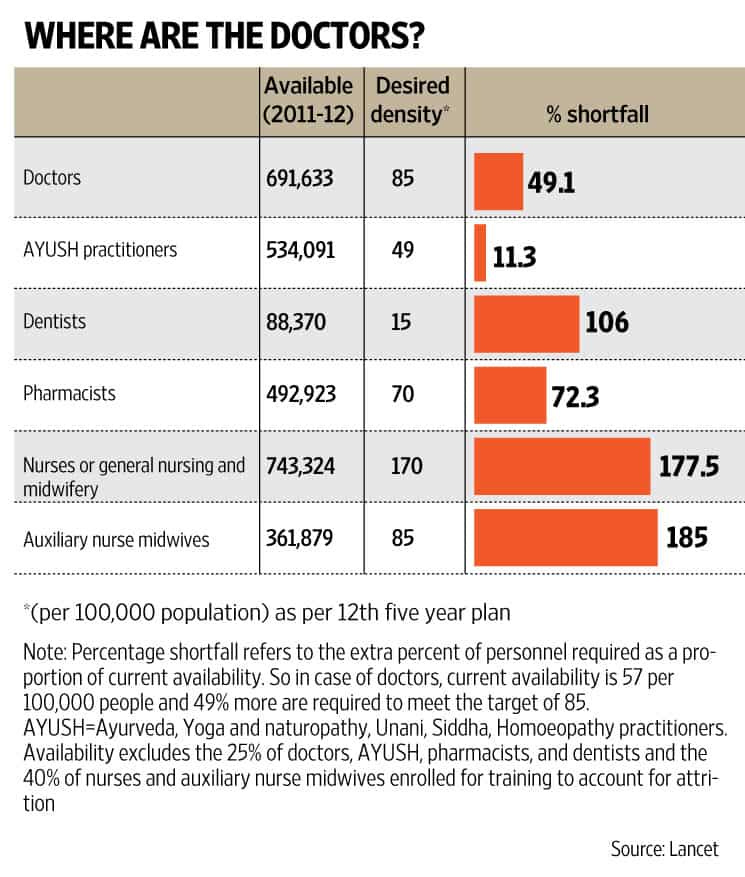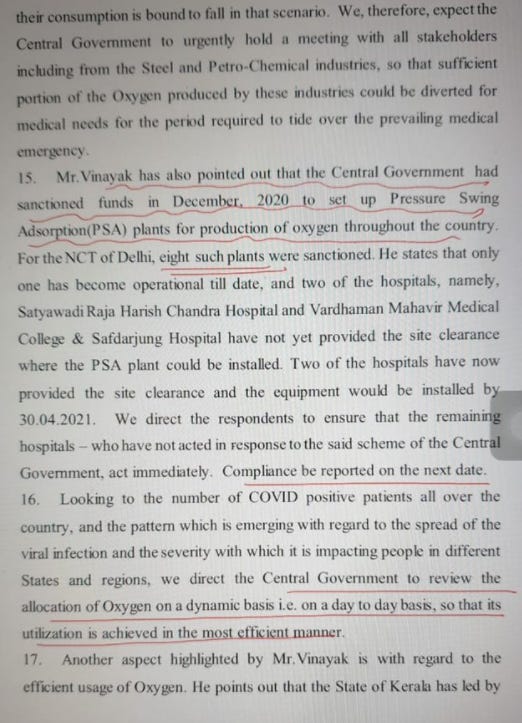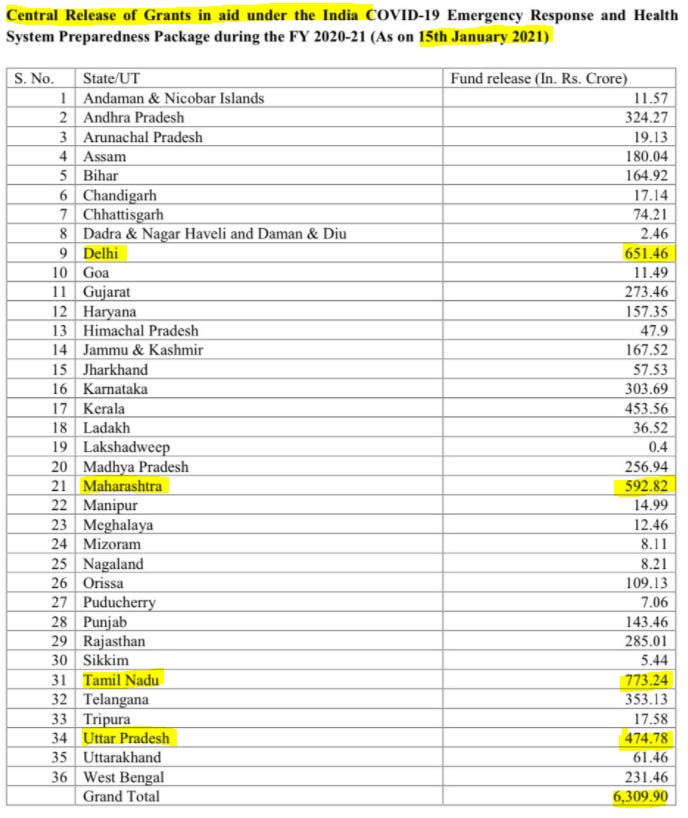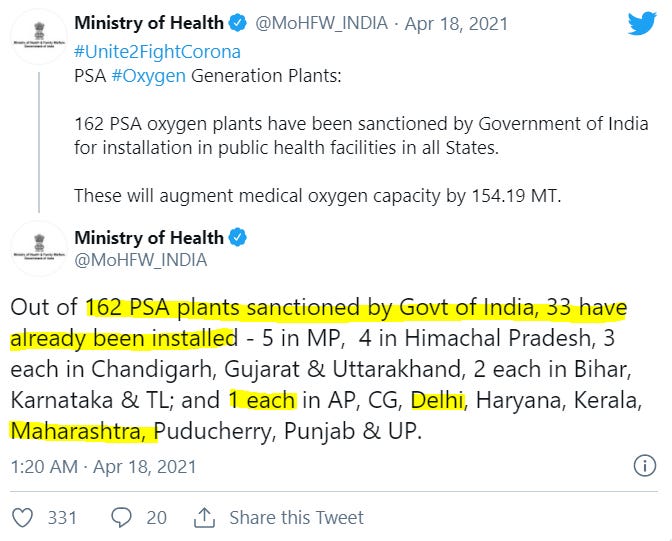Insightful newsletter of Drishtikone: Issue #290 - States fail, Center Hit for COVID
Health is a State subject. Not even a Concurrent one! Center can't do much. States are belligerent even at the cost of peoples' lives. They have done precious little. Yet world abuses Center. Why?
Image by StockSnap from Pixabay
“There is no proletarian, not even a Communist movement, that has not operated in the interests of money, and for the time being permitted by money - and that without the idealists among its leaders having the slightest suspicion of the fact.” ― Oswald Spengler, The Decline of the West
Want to sincerely thank Soundaraji and Kashipathiji for their valuable contribution to Drishtikone! Thank you so much! 🙏
When Indira Gandhi wanted to assert herself very early in her rule, it riled the American establishment. How could someone even try to have a voice? Richard Nixon and Henry Kissinger devised a plan to unleash the Khalistani movement on India. To teach her a lesson.
That inherent hatred and despising for the rise of India has never really gone away. It has remained.
What is happening today with the blocking of the raw materials for the vaccine by the US as well as the extreme negativity being circulated across the board is not a mere accident. The words and the messages are very clear. They move from a Chinese virus-created global disaster unfolding in India to Modi (even when health is a state subject) to fascism to anti-Hindu jibes (often with references to ‘cow urine’ thrown in) very quickly.
This guy is the Associate Editor of Financial Times and the India bureau chief.
It is then that you wonder - what is the real intent of the Western media?
Using pandemic for the attack on India
Last year the world’s media seeped in deep Modi-hate was livid. With one question. As vulgar and ugly as it was, it became a common refrain. (Source)
And now, the world media is behaving as if their greatest wish has been fulfilled. The cantankerous cacophony of the media marked by the glee at the deaths and crisis in India is difficult to miss in the global press.
The glee is about what these media vultures hope to achieve.
The objective, the hate, the contradictions in their messaging - Modi’s popularity despite being polarizing - is tough to miss. For those who like facts as opposed to ideological quackery from the likes of Bloomberg, here are some figures on who voted for Modi in the last election. (Source: Economic Times)
So, does one remain ‘polarizing’ when everyone across the sections is voting for him?
But hey, whoever accused Bloomberg and other Western media of having any link to truth and facts anyway.
India is reeling under the worst health crisis in a lifetime. The main impacted states are Maharashtra, Uttar Pradesh, Karnataka, Kerala, and Delhi.
We discussed in our earlier newsletter - Issue #288 - The Second COVID Spike Disaster in India - how the narrative being pushed by the Western and ideological Indian media is false at best and cunning in reality.
States and the Center - Health as a State Subject
In July 2020, when the number of COVID deaths crossed the 1,000 mark in the national capital, as the state government led by Arvind Kejriwal did nothing, the Center used the provisions of the Disaster Management Act of 2005 to take control of the situation. At that time Delhi’s Lieutenant Governor (L-G) Anil Baijal appointed a six-member advisory committee to lay out a plan for the Delhi Disaster Management Authority (DDMA). Something that the State government should have done was handled by the Lt Governor reporting to Home Minister Amit Shah.
A 10,000-bed capacity Covid-19 care facility in Delhi's Chhattarpur called Sardar Patel Covid Care Centre was created. It was staffed with over 3,000 doctors and nurses belonging to the Indo-Tibetan Border Police (ITBP) and other Central Para Military Forces. (Source)
The real issue that has hit the Indians is the highjacking of the greatest health crisis by many state governments to hit back at the Central government. They have had - as is the case in Delhi and Maharashtra - little care for their citizens. Their own overwhelming objective is political point-scoring. This struggle is not new.
State governments in India have struggled to uphold their constitutional responsibility of public health management due to budgetary, institutional and capacity constraints. The Covid-19 outbreak has revealed how over-dependent states are on the central government for technical expertise and financial support. In the past, outbreaks, such as Monkey Fever in Karnataka or Japanese Encephalitis in Uttar Pradesh and Bihar, not only exposed the shortcomings in the institutional framework for public health management at the state level, but also the lack of technical strength available with state governments to respond to such outbreaks. Despite public health being a state subject, the central government is the key actor in designing health policies and programmes. This has largely been due greater spending ability and availability of better technical resources. For instance, to advise the Ministry of Health and Family Welfare, the government is assisted by the National Centre for Disease Control, National Health System Resources Centre and the Indian Council for Medical Research (ICMR). (Source)
The dichotomy of Center-State struggle for a subject that the State is fully responsible for - comes out in the open more acutely when there is a crisis.
India’s Central Government and state governments are empowered to regulate health-related matters. The Epidemic Diseases Act is the main legislative framework at the central level for the prevention and spread of dangerous epidemic diseases. The Act empowers the central government to take necessary measures to deal with dangerous epidemic disease at ports of entry and exit. The Act also empowers the states to take special measures or promulgate regulations to deal with epidemics within their state jurisdictions. In such emergencies the states delegate some of these powers to the deputy commissioners in the districts, typically through state health acts or municipal corporation acts. Thus, responsibility for directly addressing the crisis rests with the deputy commissioner at the district level. (Source)
India’s poor health system is a reflection of decades of neglect and poor work done by the States. Even though the spending by the Indian government on health is low, the share expended by the States is far lower than the investment by the Center.
India’s fiscal expenditure on public health has been caught in the tangled mess of the current constitutional framework, with the Centre spending only about 3.6 percent of its GDP in the past year on health, leaving India to rank an abysmal 176 out of 191 countries in health expenditure. The Central government has attributed this to its lack of constitutional mandate and to the fact that states are the primary custodians of public health under the Constitution. Despite its limited spending on public health, the Centre’s contribution to the states continues to outstrip each state's individual allocation of budgetary resources to public health. (Source)
Despite so many medical colleges allowed to open up, many of them with very low educational levels, the shortfall has been very high.
The question is if health should indeed remain a state subject. Or should it become a concurrent subject? That will bring Center into play as it adds some cohesiveness to the pandemic-like situations.
The subject of ‘health’ must be transferred to the Concurrent List of the Indian Constitution from the State List, the high-level group (HLG) formed for the health sector by the 15th Finance Commission has said. Since issues like medical education and family planning fall under the concurrent list, health also should, the panel said in a report submitted recently to the Finance Commission. (Source)
Then comes the question of laws. The laws to deal with the pandemics are not there. The Center only has recourse to old and archaic laws like the Epidemic Diseases Act, 1897. Acts like the National Disaster Management Act, 2005, give a carteblanche to the Center but that is not absolute. West Bengal, for example, blocked the Central aid to Bengal just to win political points, even as the state suffered. (Source)
The rising militancy by the States to win political battles, as irresponsible as that behavior is, has led the Centre to push harder while the states keep on with their agenda shamelessly.
Even when the Central government had directed the states to set up Pressure Swing Adsorption (PSA) plants for oxygen production, hardly any work was done.
Back in January 2021, the Center had provided separate moneys to use for COVID pandemic preparation. The biggest beneficiaries were the states that have been hit the hardest!
Coincidence?
Notice that Rajasthan and West Bengal are missing from the list. Because they created NIL.
Mohalla Clinics: A case study in State’s perfidious ways
A good case study of how the state governments do very little while promoting that little work to win points with the voters is Delhi’s Mohalla Clinics.
Part of the problem was the failed Mohalla Clinic election plank - which offered nothing tangible but created tremendous strain on the local health facilities.
Aam Aadmi Party neither built any new hospital nor any flyover from 2015 to 2019. This was revealed in a reply to the RTI request filed in 2019 by Delhi resident Tejpal Singh. (Source - Yahoo)
The promise was for 23 flyovers and increasing the hospital beds to 40,000.
As for Mohalla clinics, until March 2021, only 496 mohalla clinics have been delivered in 6.5 years by the Delhi government. As opposed to the promised 1000. (Source - IE)
The ones which have been unleashed (for they are a health threat) on Delhi, are crumbling pieces of buildings with almost nothing available for the doctors.
At Delhi’s mohalla clinics, there’s a pervasive air of fear among doctors on account of their crumbling infrastructure in the middle of the Covid-19 pandemic. The fear was already quite strong over the past few weeks, but it has deepened since a mohalla clinic doctor in Maujpur tested positive for Covid-19 this week. Doctors claim they lack the preventive gear considered necessary for healthcare workers on the frontlines of the biggest health crisis the world has seen in decades. And it’s not just their own safety they are worried about — a possible infection will place their families at risk too, they fear, as it did with the Maujpur doctor. The Maujpur doctor is suspected to have contracted Covid-19 from a patient with a travel history to Saudi Arabia who consulted him on 12 March. This interaction is said to have infected a total of eight people, including the doctor’s wife and daughter. (Source)
Even these numbers - 496 - were suspect. Per one report in The Hindu last year in March, 270 of the 480 by then had been shut during the COVID and at any time 200+ were not functioning.
Despite Chief Minister Arvind Kejriwal’s assurances, over 270 of about 480 Aam Aadmi Mohalla Clinics (AAMCs) in the city were shut on Friday, mainly because employees were unable to reach the government-run facilities where treatment is provided for free, according to officials. (Source - TheHindu)
The doctors in these clinics have often not been paid their salaries for months on end.
The doctors working for Aam Aadmi Party government-run mohalla clinics in the national capital alleged that their salaries for the past three months are curerntly pending. The doctors from the South-East zone said that their salaries for the months of June, July and August are yet to be given by the government. “Earlier, there have been times when there were gaps of one month or at most two months of salary payment, but this time it has been stretched to a third month. At the beginning of this year as well, we had a gap of nearly three months and now this is the second time,” said a doctor on condition of anonymity. Another doctor working aat one such Delhi government run clinic said that there are about 50 doctors in the South-East zone who haven’t been paid their due salary. (Source)
market corner: 10 quick bytes
Oxygen Express: Indian Railways to deliver over 140 MT liquid oxygen in 24 hours; details - more
Tamil Nadu to allow Sterlite to produce oxygen, bar on operating other units - more
Australia mulls ban on flights from India, may send emergency supplies: Report - more
PowerGrid InvIT IPO opens for bidding on April 29 to raise Rs 7,734 crore - more
Oxycon: Amid Covid-19 second wave, IISER Bhopal develops affordable oxygen concentrator - more
China's state-run airline suspends cargo flights rushing COVID-19 medical supplies to India - more
Porsche India reports 52% increase in sales at 154 units in January-March quarter - more
Google CEO Sundar Pichai, his Mco
Microsoft counterpart Satya Nadella pledge support in India’s fight against COVID-19 - more
Global military spending rises 2.6% in 2020 despite COVID-19 pandemic hit - more
nota bene
Drop Kashmir - India to Pak: After a tense relationship that lasted over 2 years, India and Pakistan have activated some back-channel contacts to ease the tensions. The daily firings on the LoC have stopped following the agreement between the DGMOs of the two countries. Pak army chief General Bajwa has also made some remarks aimed at lowering tensions between the neighbors. However, analysts say that for substantial progress in ties, Pakistan will have to scale back its demand for undoing the revocation of Article 370 in Jammu and Kashmir. TOI talked to former Ambassador Vishnu Prakash to know about the status of back-channel discussions, and whether meaningful progress has been made. (Source)
Kejriwal Oxygen double-speak: Bharatiya Janata Party (BJP) lawmaker Gautam Gambhir on Monday sharpened his attack on Delhi chief minister Arvind Kejriwal over the ongoing shortage of oxygen supply in the national capital. Gautam Gambhir said that the state government is responsible for the oxygen tankers while the Centre’s job is to make the gas available. The Delhi government earlier claimed the major reason for the oxygen crisis was the obstruction of tankers from the neighboring states of Haryana and Uttar Pradesh. (Source)
Army calls the shots in Iran: In a leaked audiotape that offers a glimpse into the behind-the-scenes power struggles of Iranian leaders, Foreign Minister Mohammad Javad Zarif said the Revolutionary Guard calls the shots, overruling many government decisions and ignoring advice. In one extraordinary moment on the tape that surfaced Sunday, Zarif departed from the reverential official line on Gen. Qassem Soleimani, the commander of the Guard's elite Quds Force, the foreign-facing arm of Iran’s security apparatus, who was killed by the United States in January 2020. (Source)
Digital Yuan Vs Alipay and Wechat: In China's commercial hub Shanghai, six big state banks are quietly promoting digital yuan ahead of a May 5 shopping festival, carrying out a political mandate to provide consumers with a payment alternative to Alipay and WeChat Pay. The banks are persuading merchant and retail clients to download digital wallets so that transactions during the pilot program can be made directly in digital yuan, bypassing the ubiquitous payment plumbing laid by tech giants Ant Group, an affiliate of Alibaba 9988.HK, and Tencent 0700.HK (Source)
Imagine pigs with human hearts or mice whose brains have a spark of human intelligence. Scientists are cultivating a flock of such experimental creations, called chimeras, by injecting potent human cells into mice, rats, pigs and cows. They hope the new combinations might one day be used to grow human organs for transplants, study human illnesses or to test new drugs. In the latest advance, researchers in the U.S. and China announced earlier this month that they made embryos that combined human and monkey cells for the first time. So far, these human-monkey chimeras (pronounced ky-meer-uhs) are no more than bundles of budding cells in a lab dish, but the implications are far-reaching, ethics experts say. The use of primates so closely related to humans raises concerns about unintended consequences, animal welfare and the moral status of hybrid embryos, even if the scientific value of the work may be quite high. (Source)
video corner: Ute tribe’s ancient wisdom
The Native Americans have been all but wiped out and their culture destroyed. One, therefore, keeps looking for any wisdom that is shared by the natives from their ancient stories. Larry Cesspooch from the Ute tribe (Utah state name comes from the name of this tribe) shares some very interesting stories.
Larry Cesspooch shares his thoughts on the Ute Indian people today and shares Ute wisdom, including the Creation Story. Larry is a member of the Ute Indian Tribe, and he is a filmmaker and storyteller. He's also a veteran who served in Vietnam. He shares Ute's wisdom and language.
Today’s ONLINE PAPER: Check out today’s “The Drishtikone Daily” edition. - THE DRISHTIKONE DAILY
Nuzzle Tweets “newsletter” - with tweets and stories that we read and follow in a day in one compilation on a daily basis - Nuzzle Drishtikone - just another way to keep up with things
SUPPORT DRISHTIKONE: If you consider our work important and enriching and would like to contribute to our expenses, please click on the button below to go to the page to send in your contribution. You can select the currency (for example, INR or USD, etc) and the amount you would like to contribute. Contribute to Drishtikone
If you like this post - please share it with someone who will appreciate the information shared in this edition
If you like our newsletter, please share it with your friends and family





